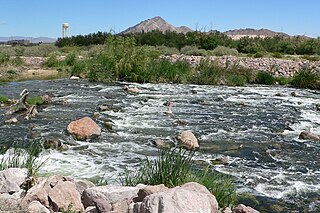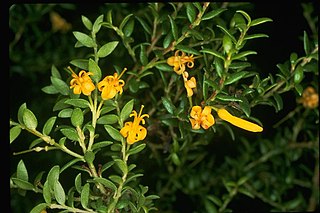
Asterales is an order of dicotyledonous flowering plants that includes the large family Asteraceae known for composite flowers made of florets, and ten families related to the Asteraceae. While asterids in general are characterized by fused petals, composite flowers consisting of many florets create the false appearance of separate petals.

Flowering plants are plants that bear flowers and fruits, and form the clade Angiospermae, commonly called angiosperms. The term "angiosperm" is derived from the Greek words angeion and sperma ('seed'), and refers to those plants that produce their seeds enclosed within a fruit. They are by far the most diverse group of land plants with 64 orders, 416 families, approximately 13,000 known genera and 300,000 known species. Angiosperms were formerly called Magnoliophyta.

Royal Botanic Gardens, Kew is a non-departmental public body in the United Kingdom sponsored by the Department for Environment, Food and Rural Affairs. An internationally important botanical research and education institution, it employs 1,100 staff. Its board of trustees is chaired by Dame Amelia Fawcett.

Gundelia is a low to high (20–100 cm) thistle-like perennial herbaceous plant with latex, spiny compound inflorescences, reminiscent of teasles and eryngos, that contain cream, yellow, greenish, pink, purple or redish-purple disk florets. It is assigned to the family Asteraceae. Flowers can be found from February to May. The stems of this plant dry-out when the seeds are ripe and break free from the underground root, and are then blown away like a tumbleweed, thus spreading the seeds effectively over large areas with little standing vegetation. This plant is native to the eastern Mediterranean and the Middle-East. Opinions differ about the number of species in Gundelia. Sometimes the genus is regarded monotypic, Gundelia tournefortii being a species with a large variability, but other authors distinguish up to nine species, differing in floret color and pubescence. Young stems are cooked and eaten in the Middle-East and are said to taste like a combination of artichoke and asparagus. The plant also contains compounds that have been demonstrated to be effective against a range of ailments. A large quantity of pollen assigned to Gundelia has been found on the Shroud of Turin, which may suggest that the crown of thorns was made from Gundelia, but this finding has been contested.

Echinops is a genus of about 120 species of flowering plants in the family Asteraceae, commonly known as globe thistles. They have spiny foliage and produce blue or white spherical flower heads. They are native to Europe, east to central Asia, and south to the mountains of tropical Africa. Globe thistle is the host plant of weevil Larinus vulpes.

Las Vegas Wash is a 12-mile-long channel which feeds most of the Las Vegas Valley's excess water into Lake Mead. The wash is sometimes called an urban river, and it exists in its present capacity because of an urban population. The wash also works in a systemic conjunction with the pre-existing wetlands that formed the oasis of the Las Vegas Valley. The wash is fed by urban runoff, shallow ground water, reclaimed water used on parks and golf courses, and stormwater.
Brassicoraphanus is any intergeneric hybrid between the genera Brassica and Raphanus (radish). The name comes from the combination of the genus names. Both diploid hybrids and allopolyploid hybrids are known and share this name.

A flower, sometimes known as a bloom or blossom, is the reproductive structure found in flowering plants. The biological function of a flower is to facilitate reproduction, usually by providing a mechanism for the union of sperm with eggs. Flowers may facilitate outcrossing resulting from cross-pollination or allow selfing when self-pollination occurs.

Ireneusz Jeleń is a retired Polish footballer who played as a right-winger or striker for the Polish national football team.

Brassica tournefortii is a species of plant known by the common names Asian mustard, pale cabbage, African mustard, and Sahara mustard, and is well known as an invasive species, especially in California.

Leucadendron discolor is a species of plant in the family Proteaceae. It is endemic to South Africa. It is threatened by habitat loss. In English the plant is known as the Piketberg Conebush and in Afrikaans as the Rooitolbos. L. discolor is a slow growing perennial. Growth of the root system and propagation, from a seed to the plant's first flower, can take up to two years. The male L. discolor 'Sunset' flowers exuberantly during early spring exposing a colorful flowerhead during this time.The flower head is composed of a dome-like receptacle, and is densely covered with small male flowers. These plants are only able to reproduce after their third year of life.

Ireneusz Paliński was the first Polish weightlifter to win an Olympic gold medal, which he did in 1960. In 1961 he won the middle-heavyweight world title, setting new world records in the clean and jerk and in the total. For these achievements in the same year he was awarded the Order of Polonia Restituta and selected as Polish Sportsperson of the Year. He finished second at the world championships in 1959, 1962–63 and 1966, and third in 1958 and 1964. In total Paliński set six world records in the clean and jerk, which was his favorite event. Domestically he won nine national titles.

Hymenonema is a genus of flowering plants in the family Asteraceae endemic to Greece. On each of the single or few stems, the species have one to three flowerheads consisting of yellow or yolk yellow ligulate florets, scaly pappus, greyish, pinnately segmented leaves in a basal rosette, and few smaller leaves on the 20–70 cm high stems. It contains two species: Hymenonema graecum, that is known from the Cyclades, and Hymenonema laconicum, which occurs in the central and south-eastern Peloponnesos.

Persoonia oxycoccoides is a species of flowering plant in the family Proteaceae and is endemic to New South Wales. It is a spreading to prostrate shrub with smooth bark, hairy young branchlets, elliptic to egg-shaped leaves and yellow flowers arranged in groups of up to thirteen along a rachis that continues to grow after flowering.

Celtis tournefortii, commonly known as the oriental hackberry is a deciduous tree in the genus Celtis.
Giuseppe Monti was an Italian chemist and botanist. He was a professor of botany and from 1722 to 1760 director of the Bologna Botanical Garden. His son Gaetano Lorenzo Monti (1712–1797) was also a botanist who continued work at the same botanical garden.

Rietavas Manor is a former Ogiński residential manor in Rietavas, Lithuania. The primary manor building hasn't survived, however many parts of the ensemble have, including the former musicians' dormitory, water tower, park, a few outbuildings, guard house, part of the wall, two gates and the Ogiński Family Chapel, where Bogdan Ogiński and his brother duke Mykolas Ogiński are buried.
Ireneusz Mamrot is a Polish football manager and a former player.

Crocus tournefortii, the Tournefort crocus, is a species of flowering plant in the iris family Iridaceae, from South Greece and Northern Crete.

Noaea is a genus of flowering plants belonging to the family Amaranthaceae. It is in the Salsoloideae subfamily.
















